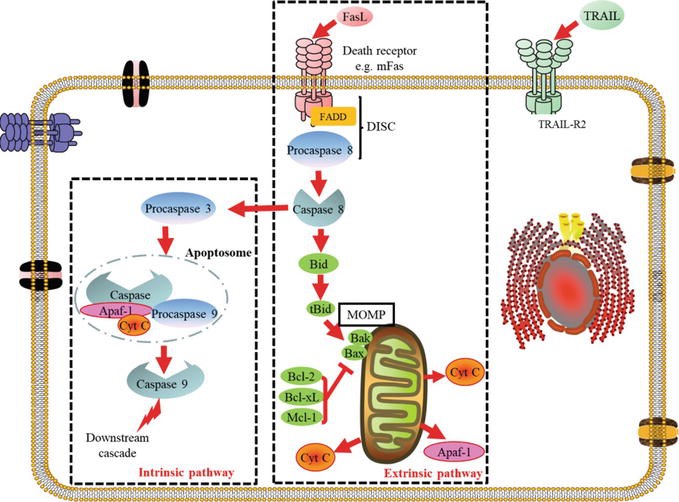Cancer-Apoptosis Pathway Phosphorylation Antibody Array
Apoptosis is an autonomous process that leads to programmed cell death to remove unwanted or abnormal cells in organisms and maintains a stable internal environment. Apoptosis mediates the programmed cell death either in a caspase-dependent or in a caspase-independent pathway. Apoptosis occurs normally during development and aging and as a homeostatic mechanism to maintain cell populations in tissues, while cancer cells obtain immortality by escaping programmed cell death. The cancer cells evade apoptosis via various mechanisms, including upregulate anti-apoptotic signals (Bcl-2, Akt, Mcl-1, etc.) and downregulate pro-apoptotic signals (Bax, Bak, Bad, etc.).
 Fig.1 The intrinsic and extrinsic apoptotic pathways.1
Fig.1 The intrinsic and extrinsic apoptotic pathways.1
Understanding the underlying mechanism of cancer resistance to programmed cell death is fundamental for efficient cancer treatment agents. Creative Biolabs offers cancer-apoptosis-related pathway phosphorylation screening service with antibody array, which consists of 155 high-specific antibodies and more than 70 phosphorylation sites involved in cancer-apoptosis-related pathways can be tested.
Related Signaling Pathway
| Signal Pathways | |
|
|
Antibody Array Targets
| Targets |
| AFX (S197) | HSP27 (S15) | NFKB-p65 (S311) | PRKCD (S645) |
| ASK1 (S83) | HSP27 (S78) | NFKB-p65 (S276) | PRKCQ (S676) |
| ASK1 (S966) | HSP27 (S82) | NFKB-p65 (S468) | PTEN (S370) |
| BAD (S112) | NFKBIA (S32/S36) | NFKB-p65 (S529) | PTEN (S380) |
| BAD (S136) | NFKBIA (Y42) | NFKB-p65 (S536) | PTEN (S380/T382/T383) |
| BAD (S155) | CHUK (T23) | NFKB-p65 (T254) | Raf1 (S259) |
| BCL-2 (S70) | IRS-1 (S307) | NFKB-p65 (T435) | Raf1 (S338) |
| BCL-2 (T56) | IRS-1 (S312) | p44/42 MAP Kinase (T202) | rpS6 (S235) |
| BCL-XL (S62) | IRS-1 (S636) | p44/42 MAP Kinase (Y204) | Src (Y418) |
| CDC2 (Y15) | IRS-1 (S639) | p53 (S15) | Src (Y529) |
| cdc25A (S75) | JAK1 (Y1022) | p53 (S315) | STAT1 (S727) |
| cdc25C (S216) | JAK2 (Y1007) | p53 (S33) | STAT1 (Y701) |
| CDK2 (T160) | JAK2 (Y221) | p53 (S37) | STAT3 (S727) |
| CREB (S129) | NFKB-p100/p52 (S865) | p53 (S46) | STAT3 (Y705) |
| CREB (S133) | NFKB-p100/p52 (S869) | p53 (S6) | STAT4 (Y693) |
| FKHR (S256) | NFKB-p105/p50 (S337) | p53 (S9) | STAT5A (S780) |
| FKHR (S319) | NFKB-p105/p50 (S893) | p53 (T18) | STAT5A (Y694) |
| FKHRL1 (S253) | NFKB-p105/p50 (S907) | S6K1 (S411) | STAT6 (T645) |
| GSK3A (S21) | NFKB-p105/p50 (S932) | S6K1 (S424) | STAT6 (Y641) |
| GSK3B (S9) |
Protocol Outline
- Extracted protein and biotinylated
- Blocked antibody array
- Incubate with treated protein and control
- Incubate with streptavidin-conjugated fluorophore
- Scan with a microarray laser scanner
- Perform densitometry and analysis
Our Analysis Service
- Suitable for protein, cell and tissue samples from human, mouse and rat
- 6×107 cells or 150 µg protein
- Set replicate spots: treated sample and control
- Results are delivered in 4-5 weeks
For more detailed information about our antibody arrays, please feel free to contact us.
Reference
- Chen, Lichan, Yanyun Zeng, and Shu-Feng Zhou. "Role of apoptosis in cancer resistance to chemotherapy." Current understanding of apoptosis-programmed cell death (2018). Distributed under Open Access license CC BY 3.0, without modification.



